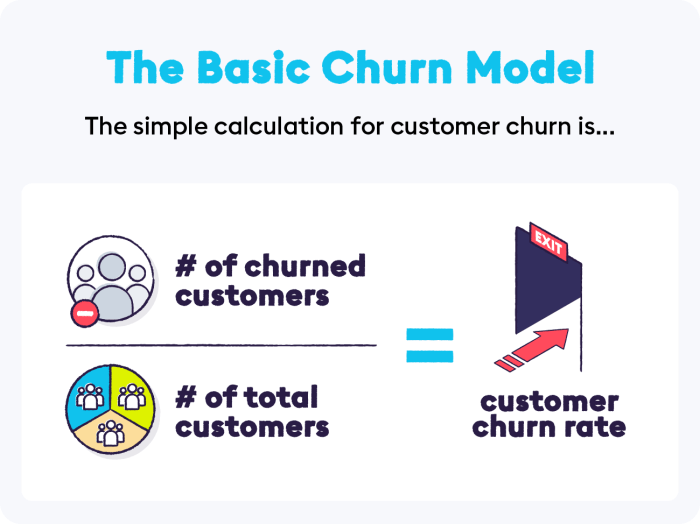Kicking off with Understanding Customer Churn, this is where we dive into the nitty-gritty of why customers bounce and how to keep ‘em hooked. Get ready to unravel the secrets behind customer retention like never before!
As we delve deeper, you’ll uncover the core concepts of customer churn and the strategies to combat it head-on. Brace yourself for a rollercoaster ride of insights and tips to boost your business game!
Definition of Customer Churn
Customer churn refers to the percentage of customers who stop using a product or service within a certain period. In the context of business, customer churn is a crucial metric that companies use to measure customer retention and loyalty. It is essential for businesses to understand why customers leave in order to minimize churn rates and maintain a loyal customer base.
Factors Contributing to Customer Churn
- Poor customer service: Customers are more likely to churn if they have negative experiences with customer service representatives or support teams.
- Price increases: Sudden or frequent price hikes can lead customers to seek more affordable alternatives.
- Competitor offerings: If a competitor provides a better product or service at a lower price, customers may switch providers.
- Lack of engagement: Customers who do not interact with a product or service regularly are at a higher risk of churning.
Impact of Customer Churn on Companies
- Loss of revenue: When customers churn, companies lose out on potential revenue from subscription fees or product purchases.
- Damage to reputation: High churn rates can signal to potential customers that a company’s offerings are lacking or that customer satisfaction is low.
- Increased marketing costs: Companies must spend more on acquiring new customers to make up for those lost to churn, driving up marketing expenses.
Identifying Customer Churn: Understanding Customer Churn
In order to identify customers who are likely to churn, companies utilize various methods to analyze customer behavior data and leverage predictive analytics.
Methods Used
- Customer Surveys: Companies often send out surveys to gather feedback on customer satisfaction, likelihood of recommending the service, and reasons for potential churn.
- Monitoring Usage Patterns: Tracking customer usage patterns can provide insights into changes in behavior that may indicate an increased likelihood of churn.
- Customer Support Interactions: Analyzing interactions with customer support can help identify frustrated or dissatisfied customers who may be considering leaving.
Importance of Analyzing Customer Behavior Data
Analyzing customer behavior data is crucial in identifying potential churners as it provides valuable insights into customer preferences, engagement levels, and satisfaction. By understanding how customers interact with the product or service, companies can proactively address issues and improve the overall customer experience, reducing the likelihood of churn.
Predictive Analytics for Identifying Churners, Understanding Customer Churn
Predictive analytics involves using historical data and statistical algorithms to forecast future events, such as customer churn. By analyzing patterns and trends in customer behavior data, companies can predict which customers are most likely to churn and take proactive measures to retain them. This data-driven approach allows companies to implement targeted retention strategies and personalized interventions to prevent churn before it happens.
Reasons for Customer Churn
Customer churn can happen for various reasons, impacting a company’s revenue and reputation. Understanding why customers choose to leave a product or service is crucial for implementing effective retention strategies.
Common Reasons for Customer Churn
- Price Increases: Customers may leave if they feel the product or service is no longer worth the cost.
- Poor Customer Service: Unresponsive or unsatisfactory customer support can drive customers away.
- Product or Service Quality: If the quality declines or does not meet expectations, customers may seek alternatives.
- Competitor Offerings: Customers might switch to competitors offering better features or benefits.
- Lack of Engagement: When customers feel disconnected or unengaged, they are more likely to churn.
Voluntary Churn vs. Involuntary Churn
- Voluntary Churn: Occurs when customers actively choose to stop using a product or service. This can be due to reasons such as dissatisfaction, better offers elsewhere, or changing needs.
- Involuntary Churn: Happens when customers churn due to external factors like payment issues, technical problems, or relocation. These customers may not have intended to leave.
Strategies to Address Customer Churn
- Improve Customer Service: Enhance support channels and responsiveness to address customer issues promptly.
- Offer Personalized Solutions: Tailor products or services to meet individual customer needs and preferences.
- Implement Feedback Mechanisms: Gather and act on customer feedback to make continuous improvements.
- Reward Loyalty: Provide incentives or rewards to loyal customers to encourage retention.
- Re-Engagement Campaigns: Reach out to inactive customers with special offers or reminders to re-engage them.
Customer Retention Strategies

Implementing effective customer retention strategies is crucial for businesses to maintain a loyal customer base and reduce churn rate. By focusing on retaining existing customers, companies can increase customer lifetime value and drive sustainable growth.
Loyalty Programs
Loyalty programs are a popular customer retention strategy that rewards customers for their repeat business. These programs incentivize customers to continue purchasing from a specific brand by offering discounts, exclusive offers, or rewards points that can be redeemed for future purchases.
- Reward Points System: Customers earn points for every purchase, which can be redeemed for discounts or free products.
- Exclusive Discounts: Providing special discounts to loyal customers encourages repeat purchases and strengthens brand loyalty.
- Personalized Offers: Tailoring promotions based on customer preferences and purchase history can increase engagement and retention.
Personalized Communication
Personalized communication plays a key role in improving customer retention by creating a more personalized and engaging experience for customers. By understanding customer preferences and behavior, businesses can deliver targeted messages that resonate with individual customers.
Using customer data to personalize emails, messages, and offers can significantly increase customer engagement and loyalty.
Measuring Customer Churn

In order to effectively manage customer churn, businesses need to measure it accurately to make informed decisions and implement strategies to retain customers.
Key Metrics for Measuring Customer Churn Rate
- Customer Churn Rate: This metric calculates the percentage of customers who have stopped using a company’s product or service over a certain period of time. It is essential for businesses to track this metric regularly to assess their customer retention efforts.
- Churn Prediction Score: This metric uses data analytics to predict which customers are at risk of churning. By identifying these customers early on, businesses can take proactive steps to prevent churn.
- Churn Revenue: This metric quantifies the revenue lost due to customer churn. It helps businesses understand the financial impact of losing customers and the importance of implementing effective retention strategies.
Difference Between Customer Churn Rate and Customer Retention Rate
- Customer Churn Rate: Represents the percentage of customers who have left the company over a specific period of time. A high churn rate indicates that a business is losing customers at a rapid pace.
- Customer Retention Rate: Shows the percentage of customers that a company has retained within a given period. A high retention rate signifies that a business is successful in keeping customers engaged and loyal.
Importance of Tracking Churn Metrics for Business Growth
- Identifying Problem Areas: By monitoring churn metrics, businesses can pinpoint the areas of their products or services that are causing customers to leave. This insight enables them to make necessary improvements to enhance customer satisfaction.
- Retention Strategy Evaluation: Tracking churn metrics allows businesses to evaluate the effectiveness of their customer retention strategies. They can determine which tactics are successful in reducing churn and focus on implementing those strategies further.
- Revenue Protection: Understanding churn metrics helps businesses protect their revenue by identifying valuable customers at risk of churning. By targeting these customers with personalized retention efforts, businesses can prevent revenue loss and ensure sustainable growth.
